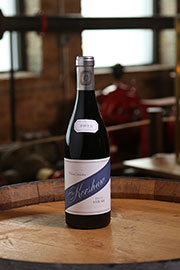- Analysis
- Vineyards
- Vinification and Aging
- Tasting Notes
- 2013 Vintage Notes
Richard Kershaw 2013 Syrah
Wine of Origin
Elgin
Varietals
100% Syrah made up of clones SH9c, SH22 & SH99.
Analysis
Wine Maker: Richard Kershaw
Alcohol: 13.7%
Hand-Picking Dates: 27th March – 4th April 2013
Harvest Brix: 22.2 – 24.2
Total Production: 6,520 bottles (roughly 540 cases) all individually marked on the label.
Elgin is surrounded by mountains, and thus there are distinct delimitations topographically as to where the region starts and finishes. The Elgin Valley is situated on an inland, hexagonal-shaped plateau, at an altitude of 300 meters, surrounded by mountains, only 10km from the Atlantic Ocean.
Within the district of Elgin there are a number of wards and sub-wards that can be identified prior to single vineyard pinpointing. These include areas around the Palmiet River, the areas south towards the southern Kloof, the areas buttressed either side of the N2, and areas to the East and West of Grabouw. Essentially temperatures rarely go above 35°C and generally one wakes up to an agreeably cool day, occasionally swirling in sea-borne mists. Typically, in February, the hottest month of the year, we have cool nights with temperatures dipping to 14°C, a morning of 16°C and beautiful clear days peaking at about 23°C.
The benefit of cooler climates is that the grape cluster stays connected to its roots for longer, developing more characteristics and achieving physiological ripeness more gradually with lower sugar levels and consequently lower alcohols. The resultant wines leave one with an impression of delicacy, but also power and insistence over warmer-climate examples, which show bolder but less-persistent flavors.
The grapes were handpicked under autumnal skies into small lug baskets and then manually sorted on a conveyor before the stems were removed.The destemmed berries fell onto a vibrating table in order to remove jacks and substandard berries before dropping uncrushed into a small 500kg conical hopper and forklifted into open- topped fermenters.The grapes underwent a 3-day maceration before spontaneous fermentation began. A gentle pigeage program was charted and the grapes remained on skins for 21-29 days.The wine was then racked to barrel under gravity and the remaining pomace basket-pressed. Malolactic then proceeded in barrel followed by a light sulphuring and 17-month maturation. No finings were necessary and the wine was simply racked unfiltered prior to bottling.
A small number of artisanal coopers were selected from Burgundy and Rhone, with only French oak chosen. 55% of the oak was new with the remainder split into 2nd and 3rd fill barrels of which 4 were 500L puncheons and the remainder 228L pièces.
Subtle, precise style built on fine tannins that educe harmony, freshness with flavors of black skinned fruit, and ground white peppercorns. In 2013, the Syrah was interpreted as having a complex savory profile wrapped around a deep fruit core, freshness of flavor with cracked pepper, black cherry and exotic spices, gracefully set on powder fine tannins.
The combination of cool Spring weather and further rain gave plenty of time for the buds to break; a uniform budbreak and flowering period with wind only starting later (and starting strongly) enabling healthy grapes with only minor damage to some of the shoots. Peak temperatures were noticeably lower than the Long Term Average (LTA) but more importantly even lower than 2012, which itself was considered a cool vintage; a cool February and March enabled good fruit set with slow and steady flavor development, although the depth of color is less than 2012.

